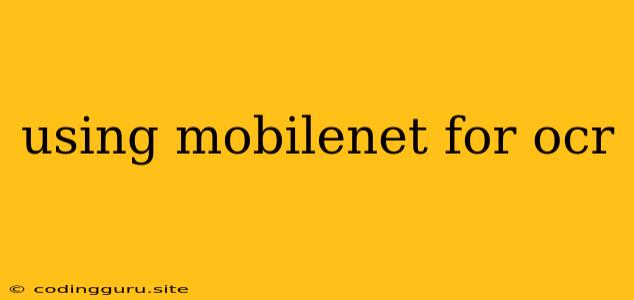Harnessing the Power of MobileNet for OCR: A Practical Guide
Optical Character Recognition (OCR) has revolutionized the way we interact with text-based information, enabling us to extract text from images and documents with ease. Among the various techniques employed for OCR, MobileNet has emerged as a powerful and efficient solution, particularly for mobile and resource-constrained environments. In this comprehensive guide, we will delve into the intricacies of using MobileNet for OCR, exploring its advantages, implementation strategies, and practical applications.
Why Choose MobileNet for OCR?
MobileNet, a convolutional neural network architecture developed by Google, has gained immense popularity in the field of computer vision due to its compact size, high accuracy, and remarkable efficiency. These attributes make it an ideal choice for OCR applications, especially when dealing with limited computational resources.
Here's why MobileNet stands out:
- Lightweight Architecture: MobileNet models are significantly smaller than traditional convolutional networks, making them suitable for deployment on mobile devices and embedded systems.
- High Accuracy: Despite its compact size, MobileNet delivers impressive accuracy on a range of computer vision tasks, including image classification and object detection, making it a viable option for OCR.
- Efficient Inference: MobileNet models are optimized for fast inference, enabling real-time OCR processing, even on resource-constrained devices.
- Versatile Applications: MobileNet's versatility extends beyond OCR, making it applicable to various tasks such as text recognition, document analysis, and image captioning.
Implementing MobileNet for OCR: A Step-by-Step Approach
To harness the power of MobileNet for OCR, you can follow these steps:
- Data Preparation:
- Image Collection: Gather a diverse dataset of images containing text in various fonts, sizes, and orientations.
- Data Augmentation: Increase the size and diversity of your dataset by applying transformations such as rotation, scaling, and noise injection.
- Labeling: Label each image with the corresponding text, ensuring accuracy and consistency.
- Model Selection and Fine-tuning:
- MobileNet Architecture: Choose the appropriate MobileNet architecture based on your accuracy and computational constraints. Consider MobileNetV1, MobileNetV2, or MobileNetV3.
- Transfer Learning: Utilize pre-trained MobileNet models for image classification and fine-tune them on your OCR dataset.
- Training the Model:
- Deep Learning Framework: Choose a suitable deep learning framework such as TensorFlow, Keras, or PyTorch.
- Training Parameters: Adjust hyperparameters like learning rate, batch size, and epochs to optimize the training process.
- Evaluation and Testing:
- Validation Dataset: Evaluate the trained model on a separate validation dataset to assess its performance.
- Metrics: Monitor metrics such as accuracy, precision, recall, and F1-score to evaluate the model's ability to recognize characters correctly.
- Deployment and Optimization:
- Deployment Platform: Deploy your trained MobileNet OCR model on your chosen platform, whether it's a mobile app, web application, or embedded system.
- Optimization: Optimize the model for efficiency and speed using techniques like quantization and model compression.
Practical Applications of MobileNet for OCR
MobileNet-powered OCR has opened up numerous practical applications across various industries:
- Document Digitization: Streamline document processing by automatically extracting text from scanned documents, invoices, and receipts.
- Mobile Payment Systems: Enable mobile payment apps to recognize bank details or credit card numbers from images.
- Image Captioning: Generate captions for images by identifying and interpreting the text present in them.
- Text Recognition in Videos: Analyze videos for text recognition, making it useful for applications such as video analysis and content moderation.
Challenges and Limitations
While MobileNet offers significant advantages for OCR, it is important to acknowledge potential challenges:
- Complex Text Layouts: Handling complex text layouts with multiple fonts, sizes, and orientations can be challenging.
- Low-Quality Images: Images with poor lighting, blurriness, or noise can negatively impact OCR accuracy.
- Language Support: Training and fine-tuning MobileNet models for different languages might require additional datasets and expertise.
Conclusion
MobileNet has emerged as a powerful and versatile tool for OCR, enabling accurate and efficient text recognition, particularly in resource-constrained environments. By leveraging its lightweight architecture, high accuracy, and efficient inference, MobileNet empowers developers to create innovative OCR applications for diverse scenarios. As the field of computer vision continues to evolve, MobileNet's role in OCR is expected to further expand, enabling us to seamlessly interact with the world's vast amount of text-based information.
